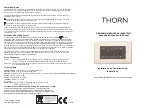
1-1
1
IPv6 MBGP Configuration
When configuring IPv6 MBGP, go to these sections for information you are interested in:
z
IPv6 MBGP Overview
z
IPv6 MBGP Configuration Task List
z
Displaying and Maintaining IPv6 MBGP
z
IPv6 MBGP Configuration Example
z
The term “router” in this document refers to a router in a generic sense or an Ethernet switch
running routing protocols.
z
This chapter describes only configuration for IPv6 MBGP. For IPv6 BGP related information, refer
to
IPv6
BGP Configuration
in the
IP Routing Volume
.
IPv6 MBGP Overview
BGP-4 is capable of carrying routing information for IPv4 only. IETF defined multi-protocol BGP
extensions to carry routing information for multiple network layer protocols.
For an IPv6 network, the IPv6 multicast topology need be different from the IPv6 unicast topology. To
meet the requirement, the multi-protocol BGP extensions enable IPv6 BGP to carry the IPv6 unicast
Network Layer Reachability Information (NLRI) and IPv6 multicast NLRI separately, and the multicast
NLRI is used to perform reverse path forwarding (RPF) exclusively. In this way, route selection for a
destination through the IPv6 unicast routing table and through the IPv6 multicast routing table will have
different results, ensuring the normal unicast and multicast operation across ASs.
Multi-protocol BGP is defined in RFC 2858 (Multiprotocol Extensions for BGP-4).
Multi-protocol BGP for IPv6 multicast is referred to as IPv6 multicast BGP (IPv6 MBGP).
This document covers configuration tasks related to multi-protocol BGP for IPv6 multicast only. For
BGP related information, refer to
BGP Configuration
in the
IP Routing Volume
.
For information about RPF, refer to
Multicast Routing and Forwarding
in the
IP Multicast Volume
.
IPv6 MBGP Configuration Task List
Complete the following tasks to configure IPv6 MBGP:
















































